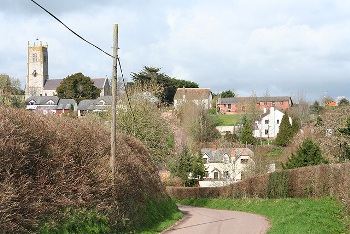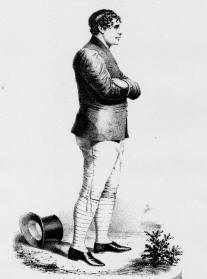Abraham Cann 1794-1864

'Portrait of Abraham Cann - Last Champion in Devon-Style Wrestling'
by Henry Caunter (attrib.) c.1846
© Royal Albert Memorial Museum and Art Gallery, Exeter
Abraham Cann was born in Colebrooke, near Crediton, in 1794, the son of farmer and maltster Robert, and Mary Cann both of Colebrooke, youngest of seven children. Robert, who was reputed to be a rum-runner, smuggled barrels of spirits being transported to him disguised in hay loads, whilst wife Mary took care of the distribution with the contraband hidden in her voluminous skirts. His grandparents Robert, miller or maltster of Upton Hellions and Sandford, and wife Jane Cann née Coombe were 4 x great grandparents of Florence Cann, who married great uncle Charley Heard, and her sister Elizabeth Cann, who married third cousin William Drew.
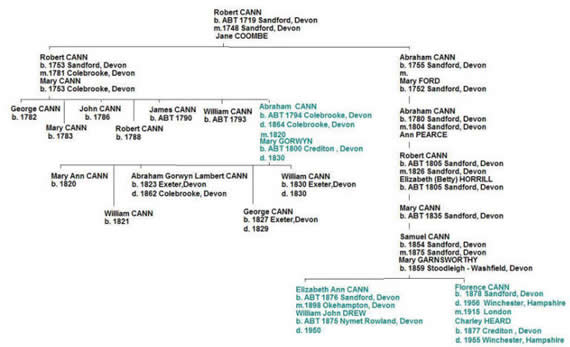 Relationship between the Canns and the Heards
Relationship between the Canns and the Heards
It is said that Abe inherited his love of sport from his father. His brothers Robert, George, William and James shared his enthusiasm and were wrestlers too, James doing particularly well. But Abe became the acknowledged champion not only in Devon but throughout the country.
Devonshire Wrestling
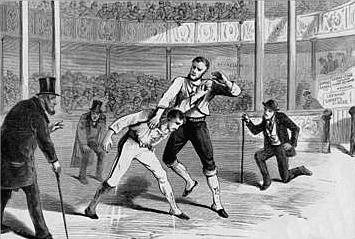
Devonshire and Cornish wrestling are similar in most respects. The Devonshire tradition allowed kicking of the opponent below the knee, with toe or heel, and to reinforce this aspect the Devonshire men would wear a shoe that was often soaked in bullocks' blood and then baked to make it rock hard. (The kicking was a two-sided coin. Skilled wrestlers would use the fleeting instability of the kick to overturn the kicker and gain a fall.) Devonshire men were allowed padding on the shins, but often they wore no more than silk stockings. Both Devon and Cornish dress styles otherwise comprised breeches and a short loose wrestling jacket, which was the only part of the dress by which a hold or 'hitch' could be taken. The hitch was central to the Devonshire style, whilst the Cornish wrestlers used a 'hug', which does not seem to have been a Devon technique.
Rings of 15 to 20 feet in diameter were marked out, with a rope and stakes. Three men were appointed as 'sticklers' or 'triers' to decide on fair play and fair falls. For a fair fall three points had to touch the ground - either both hips and one shoulder, or both shoulders and one hip.The contests would begin with "single plays". Challengers would throw their hats in the ring and take on opponents one by one - the objective being to make a 'standard'. Opponents would take up the challenge, and be eliminated after one fall. The challenger would remain in the ring for another opponent and when the second had been similarly beaten a standard was made. If the challenger was beaten, then his victorious opponent would hold the ring until he had made a standard, and so on. When the standards had been made the match would progress to double play - a knockout round when those successful in achieving standards the single play would fight, and then to triple play when the victors in the double play rounds would contest for places in the quadruple play, and so on until the champion had been decided by elimination bouts. The contest seems at times to have gone to quintuple play.

Publicity for what was to be Abe's last fight in 1841
Something in the air, the soil and the culture of Crediton and its surrounding parishes seems to have been ideal for the generation of Devonshire wrestlers. In 1710 one John Helyer had acquired sufficient standing as a wrestler to be so described in the register by the clergyman who buried him in Crediton parish church. After him came "Blind Wreford" (1747-1835) who rode to hounds and also acquired a reputation in the ring. He was followed by John Bolt (1795-1875) of Cheriton Bishop who did well at Leeds in 1825. Bolt was Abe's second at Plymouth when he fought against Polkinhorn. Of the same generation were William Luxton, George Avery, and William Vicary, Crediton, Elias Mills, Sandford and William Lamacraft of Tedburn St Mary. Then James Stone, friend an contemporary of Abe Cann, and and as well as the Champion himself, his brothers, particularly James and William. And in the 1840s William Parrott, Cheriton Bishop, and Chapple, Matthews,Brooks and Jackman of Crediton. Theirs seem to have been almost the last generation of Devonshire wrestling.By the second half of the eighteenth century it had all but died out.
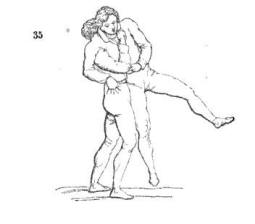
Abe was 5 ft 8½ inches tall and weighed 176lbs. He had curly black hair, and was described as "very rapid of movement". He had immense strength and stamina. He would toss around 56lb weights for the sheer fun of it, and followed hunts on foot, running and jumping across country. On one occasion about to set off from the Bull Inn in Exeter for a London competition, legend has it that he discovered there was no room for him in the coach. Unperturbed he resolved to make the journey on foot, which he did, running and walking the whole distance to reach his goal on time, and collecting a side bet for this achievement. He supposedly said the exercise had contributed to his subsequent success in the ring.
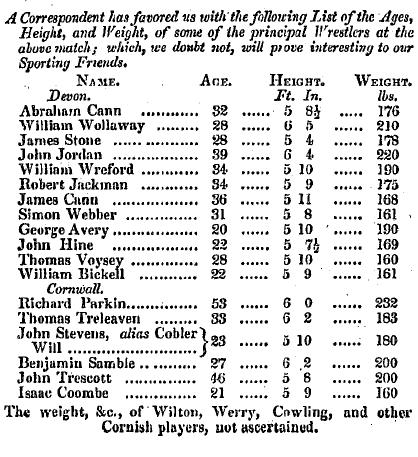

In 1824 Abe became landlord of the Moreton Inn, on Exeter's Cowick Street, itself a venue for wrestling. The sport was very popular in Exeter, with venues outside the city walls in St Thomas and St Sidwell. By 1825 he was widely accepted as the Champion of England, remaining undefeated in the contests that he entered.
In 1825- 29 Abe took part in a number of widely reported matches in Leeds, London and throughout Devon. This included a grand victory at Ashburton, over Thorn, a former Life Guard, and hero of Waterloo, who was reputed to have cut down 10 of the enemy. Abe threw him in less than 3 minutes. Abe's victories in this his heyday gained maximum publicity, helped by his high profile rivalry with James Polkinhorne of Cornwall.
Abe was usually accompanied on his trips by fellow wrestler and good friend from Crediton, James Stone, nicknamed "The Little Elephant", and often by his brother James Cann. In his history of Crediton, Venn (Venn, T.W., History of Crediton. Typescript. 1972) tells us that the activities of the Devonshire wrestlers in London were reported enthusiastically in the Society gossip columns. Dressed in the latest fashions they would promenade in the famous Vauxhall pleasure gardens, where much curiousity was shown to catch a sight of "these extraordinary Devonshire wrestlers". Along with the bare-knuckle fighters, the wrestlers must have had the popular appeal of football stars of old, if not quite the overblown celebrity status accorded them in today's tabloids. Certainly local papers reported their comings and goings, and we read of a triumphant return to Devon on the express coach Celerity in 1827, when the wrestlers were greeted by cheering crowds in Exeter.
 Vauxhall Gardens
Vauxhall Gardens
In 1828-9 Abe took over the Woolpack Inn in Bartholomew Yard, Exeter and renamed it the Champion's Arms. But this marked the beginning of his decline, both personal and professional. His 2 year-old son George died in 1829, and was buried in Colebrooke. Another son, William was born the same year, but the child died aged 3 months and was also buried in Colebrooke. Then in September of 1830, at 30 years of age, his wife Mary died.
These family tragedies seem to have laid Abe low in a way that his wrestling opponents never could. He gave up the Champion's Arms, by some accounts took to drink, drifting around. In 1831 the local press were describing him as "reduced to poverty by illness and family affliction". His well-wishers secured a job for him as a toll keeper on the Stonehouse Bridge. But Abraham continued to wrestle occasionally through the 1830s, and remained unbeaten. At some point he seems to have moved back to his brother's farm at East Coombehead, Colebrooke, where he helped on the farm. In April 1841 his backers issued a challenge to "any man in Devonshire, without exception as to weight or inches" to a fight in the vicinity of Exeter, for a prize of at least 20 sovereigns.
A Mr Ellicombe of Kingston took up the challenge and the fight was scheduled for 8 June. The prize money rose to 50 sovereigns. Then in May, Abe suffered an injury whilst wrestling a Sam Haydon at Hittisleigh Revel, and the challenge was postponed. It was finally scheduled to be held in a specially constructed ring near St Thomas Church, Exeter on 27th July, the prize having risen to 100 sovereigns. Cann was 47. His opponent, a young man of 24. More or less matched in height, the challenger was more than 30lbs heavier than Cann. The younger man demonstrated both strength and technical skill; he would have thrown any man but Cann, and proved to be more than a match for the champion. After 48 minutes of struggle, without a fall, Cann, who had been showing signs of strain, put his hand to his shoulder, evidently in pain. Two surgeons immediately attended and announced that Abraham's collar bone had "gone" - an old injury exacerbated at Hittisleigh two months earlier. And so at 2.30 pm on 27th July 1841 Abraham Cann, Champion of England, retired from the ring, assuring his opponent that he had been "as good or as fair a man as he had ever played with. "
During the 1850s his reputation as a sportsman and a champion meant that he was often asked to make celebrity appearances. He also seems to have been regularly called on to assist as Trier, or Stickler, sometimes in the company of old rival James Polkinhorne.In 1860 the local press announced that Abe had been compelled to accept parochial relief. He was described as being in distressed circumstances and ill health. Mr Langdon, of the Bull Inn, Exeter, began a subscription for him, and was soon able to report that Abe's admirers throughout the country had not forgotten the old champion. Amongst the many London subscribers was Lord Palmerston, who directed that £10 be given out of the Royal Bounty Fund, and the NCOs of the 1st and 2nd Life Guards. By October 1860 £200 had been collected, enough to give Abe with an annuity of £21.10s -to be paid quarterly - enough to support him in his declining years.

But poor Abe was to suffer further at the hands of Fate during his retirement. He continued to live with his brother in Colebrooke: his son Abraham, a carpenter, lived with them. Abe a widower, and his brother and son unmarried, relied on 70 year-old Susanna Hill to keep house for them. In 1862 Abraham and his son had been celebrating the New Year at the Bell Inn, Colebrooke. When they arrived home Abraham senior retired to bed, but his son, "tipsy", settled into the armchair for a pipe. He must have fallen asleep, for the worst happened, and a short time later he ran upstairs with his trousers and shirt on fire. He was terribly burned, and was taken to hospital, where he lingered in great pain until his death, more than two months later on March 6th. Not long after this Abe suffered an accident when the horse of the cart he was driving, with the tombstone for his son, shied, and he was thrown beneath the wheels, hurting him badly.
He was not to endure much longer. In 1864 the local papers announced the death, on April 7, at Colebrooke, near Crediton, of Mr Abraham Cann (champion wrestler), in his 70th year. Abraham died of "dropsy - 4 months" - an accumulation of water in the soft tissue, often associated with heart or kidney failure.
Memorial stone of Abraham, his wife Mary and son Abraham.
The original stone, paid for by public subscription, suffered the ravages of time and by 1877 was lying broken in three pieces. In 1880 it was replaced, through the generosity of a Mr James Wreford, with the current stone,
standing by the west door of Colebrooke Parish Church.
In 2022 Exeter Civic Society unveiled a plaque in Bartholomew Street, Exeter, in honour of Abe, on the site of the pub, the Champion's Arms, where Abe was landlord from 1828 to 1830.

